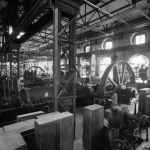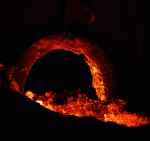3.4. Germany
In Germany industrial production of iron in large scale began in the Siegen area,
where ironstone was mined. With the introduction of coke steel production in
the Ruhr area became more and more important.
The Thyssen steel mill in Duisburg Bruckhausen and Schwelgern
grew to the size of a small town, and today two of the world's
largest blast furnaces are in operation there.
3.4.1. Völklinger Hütte (Völklingen Iron Works)
 |
The 'Gebläsehalle' of the Völklingen iron works with it's huge gas engines
(Gasmaschinen)
is not only a technical highlight, but also of aesthetical value.
You feel the huge dimensions of the hall and it's technical equipment.
The artistic design is a pleasing contrast to the
throw away architecture nowadays usually found in our modern
business areas.
|
3.4.2. Westfalenhütte, Dortmund
 |
When I had the opportunity to take the following images,
the iron still flew from the blast furnace into the railway
cars to be moved to the steel mill.
The day when I wrote these lines, the fires at the 'Westfalenhütte'
were already extinguished.
|
3.4.3. Steelworks at Gelsenkirchen and Oberhausen
 |
The images of the 'Schalker Verein' in Gelsenkirchen and the 'Oberhausener Hüttenwerk'
are amongst the oldest photographs in my archive.
|
3.4.4. Steelworks in Duisburg
 |
Now Duisburg has become the last and only town in the Ruhr area,
where you can see blast furnaces in operation.
And they are still numerous, and there are huge ones!
|
3.4.5. Krupp Steel Mill at Rheinhausen
 |
The following images show the slow death of the
former Krupp steelworks at Rheinhausen.
|
© Harald Finster, contact me



